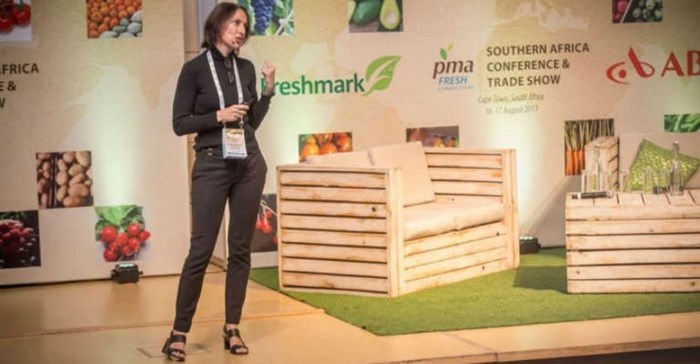Retailers in South Africa operate in an extreme social environment. On one hand there's social unrest and on the other, customers are splurging R600,000 on a bottle of whiskey. This kind of market demands a plethora of responses from retailers in terms of how they service consumers that have such dramatically different realities.
This was one of the messages that set the scene for Maryla Masojada’s keynote on ‘The State of the Fresh Produce Industry in South Africa’ at the Produce Market Association’s (PMA) Fresh Connection Conference held in Cape Town recently. The Trade Intelligence managing director discussed the trends affecting the produce supply chain and their impacts on the way companies do business.
Touching on the current macroeconomic conditions – which ultimately impact shopper, and thus retailer behaviour – she said that despite the situation being dire the innovation we’re seeing right now in terms of business behavioural changes is unparalleled. “We’re seeing responses in like we’ve never seen before from both retailers and suppliers. It’s not all doom and gloom – when the water gets really hot, we start to jump.”
The fact remains, however, that top line growth is not coming, and for that reason retailer strategy is focused on growing margins and improving efficiencies. What follows is the standout trends, strategies and market responses listed in Masojada’s talk.
Channel blurring
Grocery channels used to be distinct – manufacturing, supply, retail, informal, and a few hybrids in the middle. Bulk items were sold to suppliers, and single units to retail shoppers. But it doesn’t look like this anymore.
For example, informal independent retailers are now buying from Pick n Pay. Does that now make Pick n Pay Hypermarket a wholesaler? What does that mean in terms of what the operation is supplied with?
“The key takeout when it comes to channel blurring is that you can’t just think of wholesale as cash and carry anymore. Horizontal trade is a major issue for retailers in the wholesale market,” she noted.
Convenience
The convenience trend is prevalent in the global and local market place, and it’s changing shopper behaviour and store formats. The escalation of small store formats, like Shoprite’s Usave and Pick n Pay Local, offers a shopping experience specifically designed for convenience customers.
Convenience shopping is also reflected in the spaza shop model and in partnerships between major food retailers and petroleum companies with express shops and forecourt retail sites at their service stations.
Evolution and consolidation of wholesale
Post-1994 corporate white-owned businesses could move into township trade. This drove infrastructure for the SA retail environment. Formal independent retail came under pressure and wholesale hit the wall five to eight years ago. Masojada said that wholesalers responded in one of three ways.
They either became redistributors, meaning they could take their stock to the market via distribution vehicles to independent retailers, or they became hybrid operators and added fresh produce to their offering. “Rhino Cash and Carry, Game and Makro all went into fresh. The addition of fresh produce into wholesale drives margin and pulls shoppers into stores more often,” she explained.
The third route wholesalers took was to open franchise stores – essentially using their cash and carry to supply their own franchise operations. “In essence, they’re retail buying groups not wholesale buying groups. Putting them into a category of a wholesale cash and carry is not going to work in the current context.”
Online and physical joining forces
Online and brick-and-mortar retailers are coming together to offer their customers the best of both, and the click and collect model supports this strategy. Locally, Spar’s Good Living online shopping portal partnered up with Hirsch’s Homestore and internationally there’s the famous Amazon-Whole Foods deal.
“Why has Amazon gone into fresh? It’s not because there’s money in grocery retail. It’s about driving clicks to Amazon and getting the customer to come back more often, and hopefully they’ll pick up some higher margin along the way.”
Informal independent retail
She cautioned delegates to not underestimate the hidden economy of informal independent retail, “it’s just harder to see and reach,” she said.
In South Africa we have an informal independent retail sector that is predominantly foreign-owned and foreign-run. “We have an influx of Somalis, Bangladeshis and Pakistanis who are running these stores and have retail in their blood. Their expectations in terms of the trading environment is also quite low.”
On arrival in South Africa, they’re often welcomed into a community and immediately start working within it. In terms of where they source their stock, they cherry-pick across wholesalers. They split up to purchase the stock, and then they gather to share it and redistribute it. Because they buy collaboratively they get the best prices, which is why South African informal traders struggle to compete.
“The sector is starting to explode and these informal independent retailers are starting to put even large retailers like Shoprite under pressure.”
’Best in fresh’ strategy
Masojada said that there was a significant shift towards fresh produce, with every corporate retailer having ‘best in fresh’ in its strategy. In the retailer context ‘fresh’ expands past fruit and veg and includes the deli, the butchery and bakery.
“Retailers are decreasing floor space for groceries and increasing shelf space for fresh produce … When you walk into a store, the fresh produce is always in the front … This is what shoppers are after,” she said.
It’s not possible, however, for it to be a differentiator if everybody’s got it. She said it all boils down to execution. How does the stock get there? What is the supply chain? How is it maintained and presented in store? How does the retailer avoid waste and what is communication like with the shopper?
Supply chain conundrum
The majority of retailers are still grappling with the supply chain conundrum, Masojada said. Do they buy from the farmers market in the morning as Shoprite does, or do they use their own infrastructure to get goods to market? How that decision is made goes back to considerations like quality, reliability and cold chain.
“Supply chain is the next frontier. If you can crack the supply chain you’ll be the winner of the future, certainly in the South African context. When you attain an efficient supply chain the margins start to come.”
Expansion into Africa
Retailer strategies for expanding into Africa have become a very contested zone, but it has shifted quite dramatically, said Masojada.
While Massmart and Pick n Pay are consciously going city by city, slow and steady, Shoprite has ploughed into the continent. “Shoprite has trail blazed Africa in many respects and as a result has experienced many of the hardships that come with trading on the continent. They’re certainly looking at being Shoprite Africa as opposed to Shoprite South Africa that trades in Africa.”
She mentioned that for retailers going into Africa the focus on local sourcing and supply is massive. This largely boils down to the efficiency and cost of it, but also the part it plays in forging relationships with the regional government and local businesses.
Collaborative thinking
Concluding her keynote, Masojada referenced a study done by IGD in UK that surveyed 22 international retailers on what they thought was important in terms of their relationship with suppliers. Seventy-seven per cent answered ‘greater strategic alignment and long-term joint business planning’. “This is absolutely critical. If you don’t work together you can’t get extra margin. Collaborative business planning will drive behaviour into the future.”
She said that retailers and suppliers need to have an understanding of short-, medium- and long-term trends to deliver successful market responses. “Collaborative thinking, innovation and relevant market responses really will dictate the winners of the future,” she concluded.










































